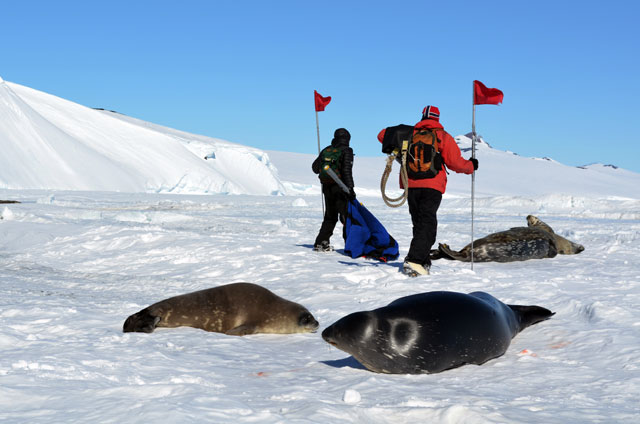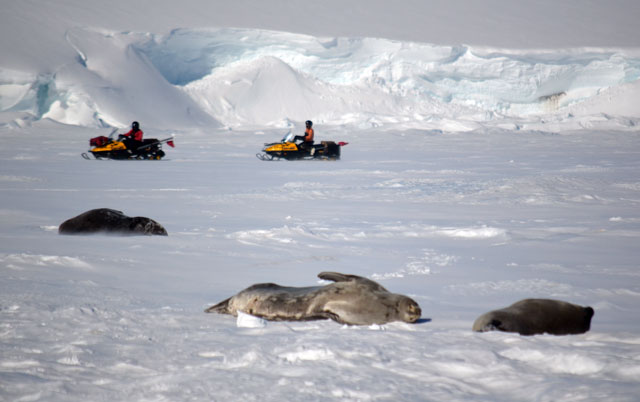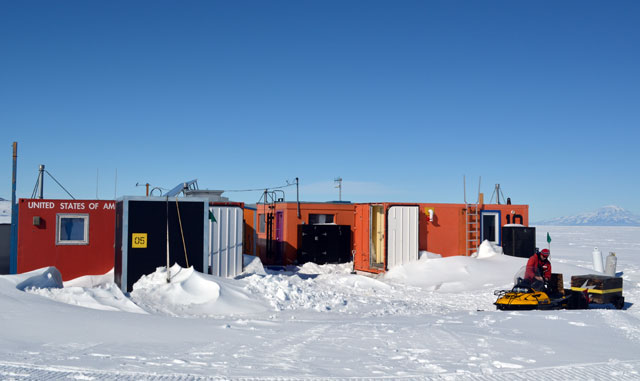Sealed and deliveredLong-term population study of Weddell seals makes some 'super' discoveriesPosted February 10, 2012
Thierry Chambert and Jesse DeVoe The trail they’re following is nearly invisible to the first-time visitor, with an occasional tattered flag on a bamboo stick the only indication that there’s any rhyme or reason to each right and left turn. But they’ve been to this place called Hutton Cliffs dozens of times over the last two months to count and weigh Weddell seals, and they are intimately familiar with every crack and bump in this ever-evolving icescape — the fast ice attached to the coast reshaped by tidal forces. “We go there every day, so we know where to step,” said Chambert, a thick French accent drawing out each word, as if in added emphasis. But the 2011-12 field season for the researchers involved in the Weddell seal population dynamics project Large cracks in the dynamic first-year sea ice forced the crew to move its base camp south of the Erebus Ice Tongue, a glacier that extends about 10 kilometers into McMurdo Sound. Several times early in the season, some team members even had to leap across the crack by helicopter to access the northern colonies of what’s known as the Erebus Bay region. The addition of bridges for light vehicles like snowmobiles eventually solved the problem, according to Robert Garrott In more than four decades since Don Siniff More than 20,000 Weddell seals have been tagged and more than 180,000 re-sightings have been logged in the project database. All the pups that have been born into the Erebus Bay population since 1973 have also been tagged, meaning about 80 percent of the seals found grunting and growling as they roll around on the sea ice are tagged. About 65 percent are of known age. Siniff had originally pioneered the use of radio transmitters in the late 1960s (post-vacuum tubes) to gain insight into seal behavior. The first radio transmitters were put on the colony at Hutton Cliffs, about 13 kilometers from McMurdo Station Eventually, the techie part of the project was discontinued, and Siniff focused on the population dynamics, producing one of the longest running datasets on a long-lived mammal. Weddell seals can live for 30 or more years. [See sidebar — Getting techie: Weddell seal population dynamics study employs different technologies.] Siniff’s legacy goes beyond mere data, however. “The project has a history of training some very successful professionals,” noted Garrott, himself a former graduate student under Siniff. A professor in MSU’s Ecology Department “We didn’t have any way to explain what was driving that variability,” Garrott said. “We layered in the mass dynamics work.”1 2 3 Next |



For USAP Participants |
For The Public |
For Researchers and EducatorsContact UsNational Science FoundationOffice of Polar Programs Geosciences Directorate 2415 Eisenhower Avenue, Suite W7100 Alexandria, VA 22314 Sign up for the NSF Office of Polar Programs newsletter and events. Feedback Form |





